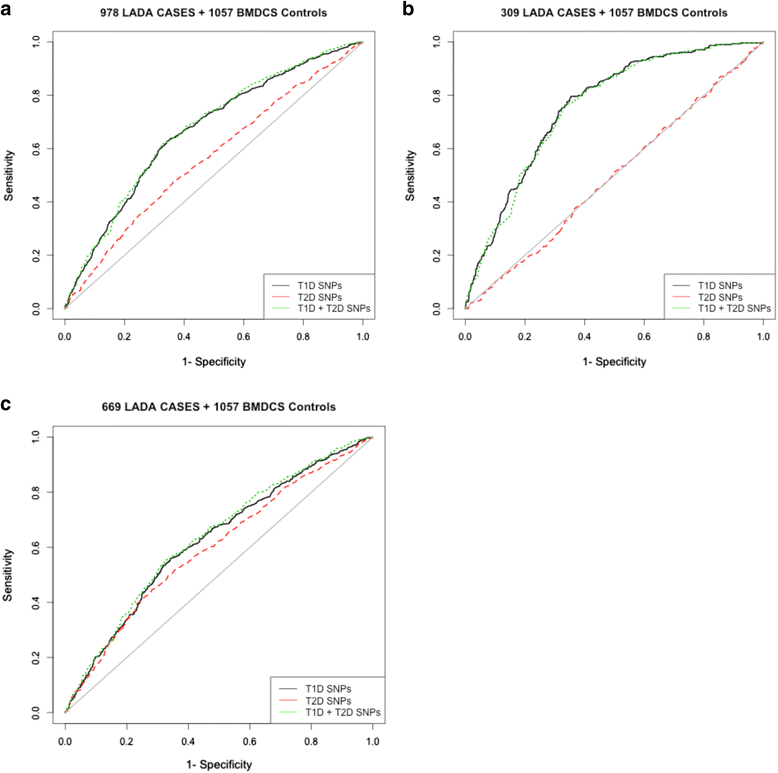Relative contribution of type 1 and type 2 diabetes loci to the genetic etiology of adult-onset, non-insulin-requiring autoimmune diabetes
- PMID: 28438156
- PMCID: PMC5404312
- DOI: 10.1186/s12916-017-0846-0
Relative contribution of type 1 and type 2 diabetes loci to the genetic etiology of adult-onset, non-insulin-requiring autoimmune diabetes
Abstract
Background: In adulthood, autoimmune diabetes can present as non-insulin-requiring diabetes, termed as 'latent autoimmune diabetes in adults' (LADA). In this study, we investigated established type 1 diabetes (T1D) and type 2 diabetes (T2D) genetic loci in a large cohort of LADA cases to assess where LADA is situated relative to these two well-characterized, classic forms of diabetes.
Methods: We tested the association of T1D and T2D GWAS-implicated loci in 978 LADA cases and 1057 non-diabetic controls of European ancestry using a linear mixed model. We then compared the associations of T1D and T2D loci between LADA and T1D and T2D cases, respectively. We quantified the difference in genetic risk between each given disease at each locus, and also calculated genetic risk scores to quantify how genetic liability to T1D and T2D distinguished LADA cases from controls.
Results: Overall, our results showed that LADA is genetically more similar to T1D, with the exception of an association at the T2D HNF1A locus. Several T1D loci were associated with LADA, including the major histocompatibility complex region, as well as at PTPN22, SH2B3, and INS. Contrary to previous studies, the key T2D risk allele at TCF7L2 (rs7903146-T) had a significantly lower frequency in LADA cases, suggesting that this locus does not play a role in LADA etiology. When constrained on antibody status, the similarity between LADA and T1D became more apparent; however, the HNF1A and TCF7L2 observations persisted.
Conclusion: LADA is genetically closer to T1D than T2D, although the genetic load of T1D risk alleles is less than childhood-onset T1D, particularly at the major histocompatibility complex region, potentially accounting for the later disease onset. Our results show that the genetic spectrum of T1D extends into adult-onset diabetes, where it can clinically masquerade as T2D. Furthermore, T2D genetic risk plays a small role in LADA, with a degree of evidence for the HNF1A locus, highlighting the potential for genetic risk scores to contribute towards defining diabetes subtypes.
Keywords: Genetic risk scores; Latent autoimmune diabetes in adults.
Figures


Similar articles
-
Systemic pharmacological treatments for chronic plaque psoriasis: a network meta-analysis.Cochrane Database Syst Rev. 2021 Apr 19;4(4):CD011535. doi: 10.1002/14651858.CD011535.pub4. Cochrane Database Syst Rev. 2021. Update in: Cochrane Database Syst Rev. 2022 May 23;5:CD011535. doi: 10.1002/14651858.CD011535.pub5. PMID: 33871055 Free PMC article. Updated.
-
Type 1 diabetes presenting in adults: Trends, diagnostic challenges and unique features.Diabetes Obes Metab. 2025 Aug;27 Suppl 6(Suppl 6):57-68. doi: 10.1111/dom.16402. Epub 2025 Apr 15. Diabetes Obes Metab. 2025. PMID: 40230204 Free PMC article. Review.
-
Interventions for latent autoimmune diabetes (LADA) in adults.Cochrane Database Syst Rev. 2007 Jul 18;(3):CD006165. doi: 10.1002/14651858.CD006165.pub2. Cochrane Database Syst Rev. 2007. Update in: Cochrane Database Syst Rev. 2011 Sep 07;(9):CD006165. doi: 10.1002/14651858.CD006165.pub3. PMID: 17636829 Updated.
-
Intravenous magnesium sulphate and sotalol for prevention of atrial fibrillation after coronary artery bypass surgery: a systematic review and economic evaluation.Health Technol Assess. 2008 Jun;12(28):iii-iv, ix-95. doi: 10.3310/hta12280. Health Technol Assess. 2008. PMID: 18547499
-
Impact of residual disease as a prognostic factor for survival in women with advanced epithelial ovarian cancer after primary surgery.Cochrane Database Syst Rev. 2022 Sep 26;9(9):CD015048. doi: 10.1002/14651858.CD015048.pub2. Cochrane Database Syst Rev. 2022. PMID: 36161421 Free PMC article.
Cited by
-
Type 1 diabetes in Africa: an immunogenetic study in the Amhara of North-West Ethiopia.Diabetologia. 2020 Oct;63(10):2158-2168. doi: 10.1007/s00125-020-05229-x. Epub 2020 Jul 23. Diabetologia. 2020. PMID: 32705316 Free PMC article.
-
Genetics of Type 1 Diabetes Comes of Age.Diabetes Care. 2020 Jan;43(1):16-18. doi: 10.2337/dci19-0049. Diabetes Care. 2020. PMID: 31862821 Free PMC article. No abstract available.
-
Characteristics of the Gut Microbiota and Metabolism in Patients With Latent Autoimmune Diabetes in Adults: A Case-Control Study.Diabetes Care. 2021 Dec;44(12):2738-2746. doi: 10.2337/dc20-2975. Epub 2021 Oct 7. Diabetes Care. 2021. PMID: 34620611 Free PMC article.
-
Adult-onset autoimmune diabetes.Nat Rev Dis Primers. 2022 Sep 22;8(1):63. doi: 10.1038/s41572-022-00390-6. Nat Rev Dis Primers. 2022. PMID: 36138034 Review.
-
First Genome-Wide Association Study of Latent Autoimmune Diabetes in Adults Reveals Novel Insights Linking Immune and Metabolic Diabetes.Diabetes Care. 2018 Nov;41(11):2396-2403. doi: 10.2337/dc18-1032. Epub 2018 Sep 25. Diabetes Care. 2018. PMID: 30254083 Free PMC article.
References
-
- Hawa MI, Kolb H, Schloot N, Beyan H, Paschou SA, Buzzetti R, Mauricio D, De Leiva A, Yderstraede K, Beck-Neilsen H, et al. Adult-onset autoimmune diabetes in Europe is prevalent with a broad clinical phenotype: Action LADA 7. Diabetes Care. 2013;36(4):908–13. doi: 10.2337/dc12-0931. - DOI - PMC - PubMed
-
- Zhou Z, Xiang Y, Ji L, Jia W, Ning G, Huang G, Yang L, Lin J, Liu Z, Hagopian WA, et al. Frequency, immunogenetics, and clinical characteristics of latent autoimmune diabetes in China (LADA China study): a nationwide, multicenter, clinic-based cross-sectional study. Diabetes. 2013;62(2):543–50. doi: 10.2337/db12-0207. - DOI - PMC - PubMed
MeSH terms
Substances
Grants and funding
LinkOut - more resources
Full Text Sources
Other Literature Sources
Medical

